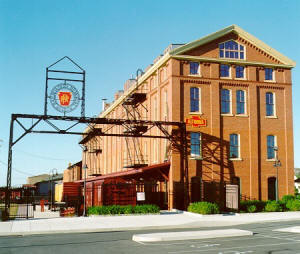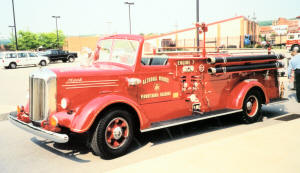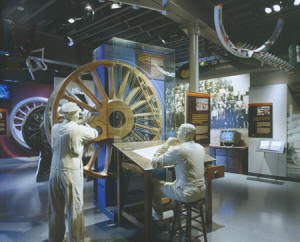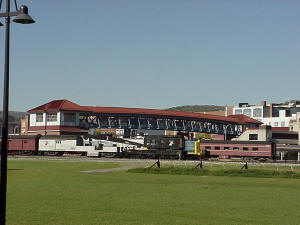|
|
Rebirth of a Museum |
|
story by Scott Cessna |
The Railroaders Memorial Museum in Altoona, PA has undergone one of the most public airings of an organization’s inner workings that one can imagine. Yet, 3 years after the dire financial condition at this institution was first made public, the Museum is now open for the 2005 season. What follows is how we found ourselves in such a tenuous situation and, more importantly, what we learned from being there.
It will be very beneficial for you to understand where the Railroaders
Memorial Museum comes from. While the building everyone equates with the
Museum today, the 123-year old former PRR Master Mechanics Building,
opened in April 1998, the Museum is nearly 33 years old. Chartered as a
not-for-profit, 501c3 organization on October 30, 1972, the Museum was the
brainchild of a group of Altoona citizens led by Mr. Ray Garvin. Mr.
Garvin was not a native of Altoona but understood the hurt felt by the
local population when Altoona was passed over as the site of the
Railroad Museum of
Pennsylvania in the 1960s. The architect’s drawings of that
proposed facility are in the Museum collection. The Museum was to be
housed in a combination of the former PRR Test Plant building and a new
facility to be constructed on the property now occupied by the Station
Medical Center, just next door from where the Museum was eventually built.
After nearly decade of fundraising, aided by a requirement by the Altoona
Redevelopment Authority that the owners of the then newly-constructed
Station Mall property donate 5 acres of ground to the Museum committee,
the Railroaders Memorial Museum opened in a 10,000 square foot building at
the corner of 13th Street and Ninth Avenue on September 21, 1980. There
the Museum lived until that day in April 1998 when the organization took
that giant leap forward with the opening of the Master Mechanics
Interpretive Center. After 3 years of planning and renovation, the Museum
went from an organization that started with $4,000 per month in total
operating expense to one with a $4,000 per month electric bill.
| "After 3 years of planning and renovation, the Museum went from an organization that started with $4,000 per month in total operating expense to one with a $4,000 per month electric bill." All photos courtesy of the Railroaders Memorial Museum. |
It is important that you understand the history as to not
make the mistake of thinking that this was an organization with no
operational track record. Not so long before April 1998 came along, the
Museum helped make ends meet by doing things such as manning the front
desk on weekends with Board Members who took turns working on Saturdays
and Sundays. This is one example of the type of practice that fell by the
wayside when the new Museum became a reality. The reality quickly became
that $5,000,000 in capital funding was not going to pay to heat and cool
the building once the contractor left the site.
The Museum hemorrhaged from the very first day it opened in April 1998.
Lack of an operating endowment and 20 years of little work being done to
make the Museum the beneficiary of local resident’s planned-giving and
other estate planning decisions just added to the problem. Just when much
of the “old money” in Altoona railroading history was being probated, the
Museum had to live with the fact that not enough had been done to
previously win the hearts and minds of those aging and passing donors.
Those estates that did give unrestricted contributions to the organization
saw the money eaten up in covering operating costs rather than having the
gift live on in perpetuity through the management of an endowment.
Six-digit losses piled on year after year and in May of 2002, just 4 years
after opening the front door for the first time, the Museum bank account
and line of credit couldn’t take it anymore. The method of accounting
being used and the manner in which those statements were prepared and
presented did not give the Board the necessary tools to make informed
financial decisions until it was too late.
It was May of 2002 when I received my first phone call about the Museum
situation. I was President of an organization known as the Altoona Chapter
of the Institute of Management Accountants. It is a group comprised of
many of the CFOs, Controllers, Finance VPs, etc in the Blair County,
Pennsylvania area. I was asked to attend a meeting with the Museum
Director and Finance Officer. After the meeting I knew why we were told
little in advance. I’m not sure how many of us would have attended if we
knew beforehand what we came to know during the meeting. The Museum was
days or hours from closing. Withholding taxes couldn’t be paid, utilities
were going to be shut off, nobody would stock the Museum Store with
product, and the bank was calling the line of credit due and payable.
Our group took a hard look at the financials and made some immediate cost
cutting recommendations. Luckily, being late May, the Museum was entering
its busy season and cash flow was certainly going to improve in the
short-term. Shortly after the initial meeting of the “crisis committee,” I
was approached to take an even more active role in the Museum’s
activities.
The Museum Board was asked at the May 2002 meeting to resign en masse. It
was felt that in order to right what was wrong, it was easier to ask
everyone to step down and reorganize from the bottom up rather than ask
certain individuals to go and others to stay. This left a 3-person
committee to govern the Museum in the interim. What they needed was a 4th
person to act as an interim Board Treasurer. I was asked by the interim
President if I would serve in the Treasurer’s capacity. I agreed, even
though I knew the gravity of the Museum’s finances.
I approached my boss about spending some time at the Museum. As a gracious
supporter of both the Museum and other community organizations, he agreed
to give me time during the day to see what I could do to correct the
situation. I was Chief Financial Officer of The Hite Company, a regional
leader in the electrical wholesaling industry at the time. Also convened
during that time was a Marketing Committee to work on how the Museum
message and fundraising appeal would be taken to the public.
I was given day-to-day authority to “run” the Museum and most operational
decisions made from that point on were made by me, with assistance from
the other 3 members of the interim committee, and enacted by the existing
staff. Not that there was much staff. I won no popularity
contests when I first arrived at the Master Mechanics Building. An
organization that opened in 1998 with over 30 employees had dropped to 19
by 2002, and then, between decisions I made and consulting decisions made
by The Westsylvania Heritage Corporation, the staff had been trimmed to
11. This was the single largest cost-cutting decision made.
The summer of 2002 was a productive one. The public responded fairly well
and rapidly enough to have the Museum survive for the 100-day “busy
season.” One big hurdle remained. Railfest was the largest event on the
Museum calendar every year and was responsible for a large portion of the
revenue raised each season. How was the Museum going to pull this event
off given the diminished capabilities of the reduced staff?
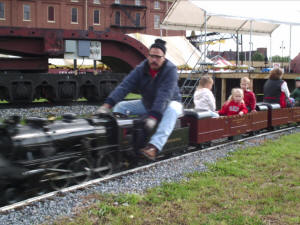 |
| "Railfest was the largest event on the Museum calendar every year and was responsible for a large portion of the revenue raised each season." |
The Railfest committee went to work feverishly to make the event a success. One component was the continued cooperation of Norfolk Southern Corporation in allowing us to run our annual excursions on Horseshoe Curve. The other key to the event was the involvement, support, and unselfish dedication of the Juniata Terminal Company. Had Bennett and Eric Levin not taken care of many of the equipment and logistical arrangements, the Railfest excursions would never have taken place. This would have sounded the death knell for the Museum as there would have been no funds in the bank account to see the Museum through the winter.
| "Had Bennett and Eric Levin not taken care of many of the equipment and logistical arrangements, the Railfest excursions would never have taken place." |
As it was, things were going to be tight over the winter.
I made what was an unpopular decision to some, but one that I felt was necessary. The
Museum had never closed over the winter months although the Visitor Center
at Horseshoe Curve, also a Museum responsibility, was always closed during
the winter quarter of January through March. The Museum always ran a
deficit during that period of the year and, starting six-figures in the
red every year, was never able to climb out of that early-season hole. I
made the decision that the Museum would be closed except for group
tours during the first quarter of 2003, and each year thereafter. This
decision ultimately saved the Museum over $100,000 that first winter.
As winter approached, my status once again changed. The other 3 members of
the interim board asked me if I would consider resigning my CFO position at
The Hite Company and taking the job of Executive Director of the
Railroaders Memorial Museum and the Horseshoe Curve National Historic
Landmark. After taking 10 minutes to think about it and giving my current
employer 2 weeks notice, I found myself behind the Director’s desk at the
Museum.
My training is not in Museum Studies. I have an accounting degree and have
spent my entire adult working life as an Air Force Budget Analyst and
private sector Controller/CFO. I set to work with one goal in mind. Make
the prudent, although sometimes painful, financial decisions that would
keep the Museum open but do it in such a way as to make what was going on
as invisible to the visitor as possible. That has been an overriding theme
during the 3 years we have been trying to make things financially stable
in Altoona. (Subsequent audits by our outside CPA firm and the IRS
uncovered no evidence of fraud, simply a case of revenues not meeting
expenses.) Make the changes that need to be made but don’t detract from
the visitor experience. If the choice was remodel a bathroom or provide
cell phones to staff, the decision was an easy one. Provide a bright,
clean, and hopefully interesting place for visitors to enjoy themselves.
Many of the initial decisions related to getting our expenses under
control were made using a simple cost-benefit analysis. The Museum was in
no position to fund "nice to have" items. The priority had to be the "need
to have" items. My position and the position of the interim Board was that
as stewards of "public" money, both government and private funds, great
care should be exercised over how it was spent. It should be spent to
support the "public" face of the Museum. What was the return on the
investment of funds towards a particular issue? Sometimes that return is
easily measured as income; spend money to make money. However, sometimes
the return is more indirect. Money that builds longer term
business relationships that will benefit the organization in the future is
also well spent.
The single most important tool to move the Museum forward was an operating
budget; a budget that was realistic and enforceable. Without someone who
is responsible to track actual verses budgeted figures in a timely
enough fashion to make changes, the budget process is a waste of time.
Line by line, the budget was examined to root out waste.
More importantly, the revenue side of the budget was examined for
opportunities. Expenses were approved based on the income categories they
supported. For example, if your budget calls for an increase in
attendance, then the expense side of the equation should contain
appropriate levels of funding in marketing and advertising to support it.
If the desire is higher levels of membership, then the expense budget
should contain allowances for things such as printing and postage. Too
often, the revenue and expense budgets in an organization are created
independently of each other and do not reflect the same priorities.
I examined every recurring expense the Museum had. Where we could do
without, we did without or we replaced the paid service with that of a
volunteer. Nothing was immune from scrutiny. Things as small as paid snow
removal service was stopped and replaced by volunteer labor. Instances of
poor facility design such as separate admissions and store checkouts were
changed cutting staffing costs in half. The original Museum building,
closed to the public, non-productive, and used for storage was reopened,
remodeled and made available for banquets, wedding receptions, and
meetings. These sorts of changes, while small individually, added up to
tens of thousands of dollars per season in new revenue or reduced cost..
We went back to school on the building’s HVAC system and found ways to
improve our efficiency saving thousands of dollars per heating and cooling
season. We examined visitor numbers and decided what adjustments needed to
be made to our operating hours.
Perhaps the biggest change was that of what I will refer to as
organizational attitude. The newly formed Board of Directors, along with
my staff and I, saw the need for the Museum needed to present itself in a
new light. Try to remove the impression, first, that we were a collection of
dirty, rusty old railroad relics stored in acid free boxes not on display
for the public to see and, second, become what we felt was necessary for survival.
We needed to be less a “museum” and more a tourist attraction; at least in
attitude. Nobody was beating down our doors to come do research in our
archives. Nobody from academia was huddled at a table wearing white gloves
examining our collection of artifacts. We had to begin attracting mom, dad
and the 2.5 kids to come enjoy our facility.
We began this quest by trying to get locals to attend. The vast majority
of our visitors were, and still are, from out-of-town. Nearly a full 80%
of them, in fact, drive more than 60 minutes to get here. However, we
needed the support of the local residents, which in turn meant the support
of the local business community. We did this very successfully with an
aggressive special events calendar. The Museum hosted very few special
events in the past. Railfest was a staple as well a visiting model train
display and some recurring holiday events. However, we opened the special
event offering up to appeal to those people who might not otherwise feel
they had an interest in railroading. Sadly, there are not enough pure
railroad enthusiasts to live by their money alone. We needed to attract
the local public and find ways to get them back to the Museum as repeat
customers.
Our events started to include things like our annual
Firefighter’s Festival. We fill the lawn and parking lot of the Museum
with fire apparatus from departments all over Central Pennsylvania. What
does this have to do with a railroad museum? Frankly, not much. But it
does have everything to do with a RAILROADER'S Museum. This Museum has
always been about the people, not the “things.” It is the sort of event
that attracts people who would not otherwise set foot on the property.
Once inside the fence line, we give them the opportunity to see the Museum
and they invariably enjoy it. We also try to make some connection to the
railroad story. In this case, we put a temporary exhibit detailing the
history of local railroad firefighting in place. We repeated that model
with event after event.
We turned the 20,000 square foot lawn in front of the Museum into a
center-city public gathering place. We installed a stage on the 120
foot-long depressed center flat car in our collection. Now, organizations
in the area that never had a working relationship with the Museum use the
stage and yard to host all sorts of events. The Museum itself is now the
site of receptions, office parties, lectures and a myriad of other
gatherings that have no particular railroad history purpose whatsoever
other than to fulfill our mission of educating the public about the
railroad’s place in local and national history.
The Master Mechanics building was covered in signs that said “No Food or
Drink Past This Point”. Those signs are gone. The building is rented by
local companies, by groups in town using the local convention center, the
local Chamber of Commerce, and many others who are looking for a unique
venue to host an event.
The organization has received some criticism for hiring an accountant to sit
in the Director’s seat. It was felt that the Museum’s educational mission
and the presentation and conservation of the collection might suffer.
There was a feeling among some that I might make decisions solely based on
the financial implications and not what would be good for the Museum’s
mission. My feeling is that you will forever run the risk of not being
able to present any mission without first examining the financial
implications of what you are doing. We set out from the beginning to, at
worst, make what the Museum was going through invisible to the visiting
public. I think we did that. In fact, I think we have been able to make
decisions that are not only prudent financially, but have enhanced the
visitor experience at the same time. We listen to our visitors. We try to
provide them material they are interested in seeing and experiencing while
keeping true to our mission statement.
We have embarked on a program to develop new exhibits in the building. Most of the Museum had not been updated since opening in 1998. We are trying to change that. Much of the rolling stock outside had been, at worst, neglected, and at best, ignored, for years. Progress is slow but we are also trying to remedy that unsightly situation, a product of a poor accession policy and no funds for upkeep, by thinning the collection that doesn’t meet our mission and concentrating on the conservation, restoration and interpretation of the rest.
Our approach has been to keep our operating budget at a manageable level
and broaden our offerings to include the casual and heritage tourist. This
endeavor in its most basic form still has to be about making revenue equal
expense. While I want the same railfans visiting us that visit the
facilities at the Railroad Museum of Pennsylvania and the
B&O Museum, I
also want the same people visiting us that are visiting Hershey Park and
the Liberty Bell. We can’t make ends meet any other way.
The development landscape has changed. There are too many nonprofit
organizations representing good causes competing for dollars that get more
limited every year. We still chase our share of government grant dollars,
but those dollars represent less than 10% of our operations budget; down
from the 30 and 40 percent during the height of the financial crisis. We
need those dollars desperately and do rely on them to help us make ends
meet. However, we refuse to put ourselves in the position where those
public dollars determine life or death at the Museum. We need to have a
plan in our back pocket to survive if some year the government faucet is
turned off.
The effort has been monumental and I could not have come through it
without the support of my staff, my Board, and the support of the local
business community. Most of all, we can’t continue to make it without the
support of the visiting public. The Museum has had visionary leaders from
Ray Garvin to former Director Peter Barton. Each brought a certain talent
to the task at hand. I’m pleased to be lending my particular talents to
effort today.
The visitor drives everything we do. I expect my staff to ask themselves
one question every time they budget how they propose to spend their day.
Is what I’m about to do going to enhance the visitor experience here? They
know what to do if the answer is no.
